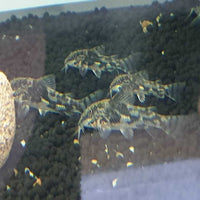Distribution
Occurs in tributaries of the coastal rios Guapi, Capivari, and Inbomirim in south-eastern Brazil, between Rio de Janeiro and Santa Catarina.
Type locality is ‘Fazenda da Japuhyba near Angra dos Reis, 22°59’S, 44°17’W, Rio de Janeiro, Brazil’.
Habitat
Although found in coastal basins, the fish only occurs in freshwater; this and all species in the genus inhabit small flowing tributary streams and still ponds having a substrate of sand or fine pebbles often covered by mud (Britto & Reis, 2005).
Maximum Standard Length
90 – 100 mm; the largest of the known Corydoradinae.
Aquarium Size
Minimum base dimensions of 120 ∗ 45 cm or equivalent are recommended.
Maintenance
Ideally use a substrate of fine sand, although rounded gravel is an acceptable alternative provided it’s kept scrupulously clean.
Other décor is largely down to personal choice, but some cover should be provided, particularly if you wish to keep more than a single male.
Water Conditions
Temperature: 16 – 24 °C
pH: 5.5 – 7.5
Hardness: 18 – 215 ppm
Diet
Scleromystax spp. are foraging omnivores, and most will accept sinking dried foods as well as small live and frozen varieties such as chironomid larvae (bloodworm), Tubifex, etc. Feeding a varied diet will ensure the fish are in optimum condition.
Under no circumstances should they be expected to survive on ‘left-overs’ from other inhabitants of the aquarium or relied on to ‘clean’ the aquarium.
Behaviour and CompatibilityTOP ↑
Males are aggressively territorial towards one another and cannot be maintained together in smaller aquaria, otherwise peaceful..
Sexual Dimorphism
Male has a white/gold stripe against black on the forehead, more defined spotted pattern on the head and facial bristles like a beard. Females have a more rounded body, particularly when in breeding condition, and are slightly larger.
Reference: https://www.seriouslyfish.com/species/scleromystax-barbatus/

